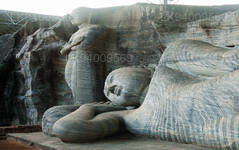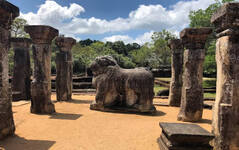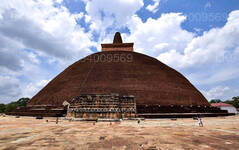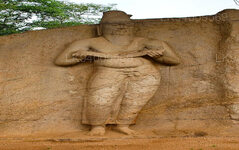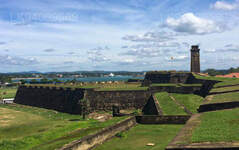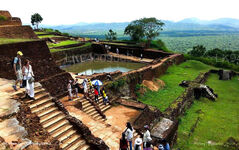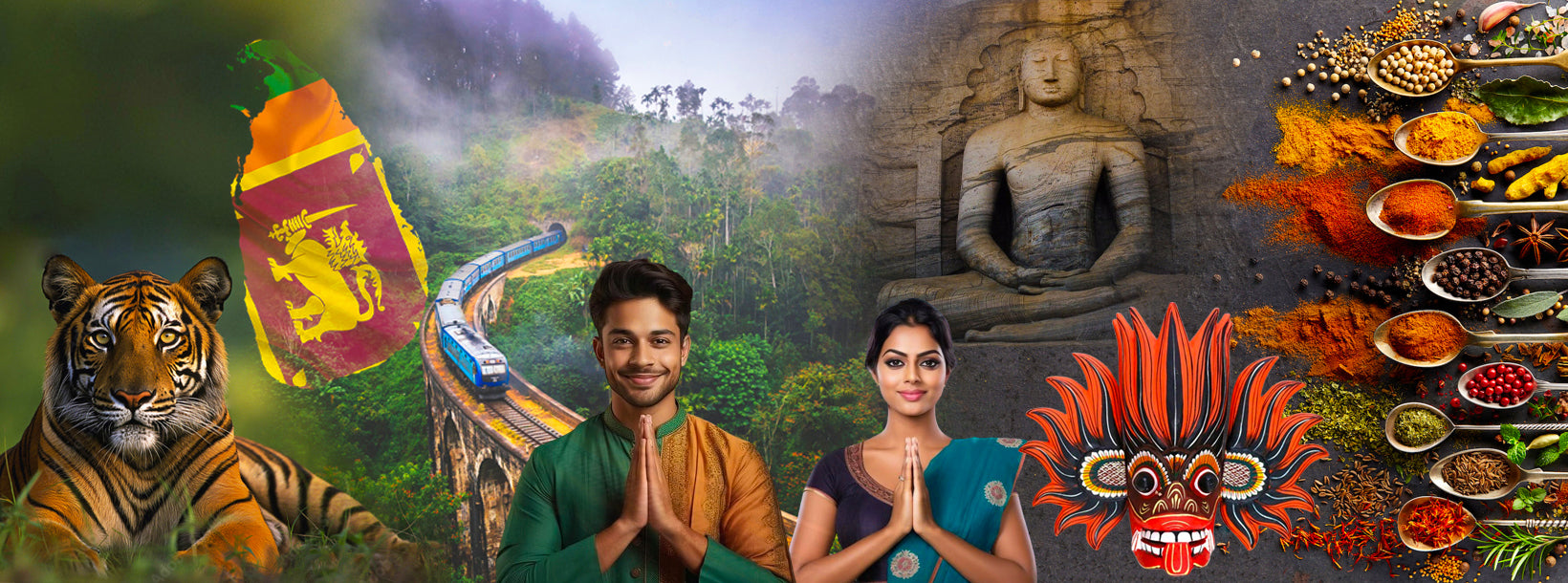
Шри-Ланка
Шри-Ланка, островное государство в Южной Азии, славится своим богатым культурным наследием, разнообразными ландшафтами и дикой природой. Среди достопримечательностей — древние храмы, нетронутые пляжи, пышные чайные плантации и яркие фестивали. Уникальное сочетание культур, тёплое гостеприимство и изысканная кухня делают Шри-Ланку привлекательным местом для путешественников.
History
A teardrop-shaped island cast adrift in the Indian Ocean, Sri lanka is filled with cultural and natural treasures. Indians, Portuguese, Dutch and British have all left their marks here, making for a delightful mix of ancient cities, monuments and grand colonial architecture.
At the same time, palm-fringed beaches are never far away and lush mountainous greenery beckons further inland. It’s clear why Marco Polo proclaimed Sri Lanka as one of the best islands in the world.
Sri Lanka is one of those places where history seems to fade into the realm of legend. Sri Lanka’s second highest mountain, Adam’s Peak is said to be the very place where Adam set foot on earth, having been banished from heaven. Meanwhile buddhists claim it is Lord Buddha’s footprint itself on Sri Pada which was placed in his final visit to the island. And isn’t Adam’s Bridge (the chain of islands linking Sri Lanka to India) the very series of stepping stones laid by the monkey god Hanuman in his mission to rescue Sita from the clutches of Rawana, the demon King of Lanka, in the epic Ramayana?
History of Sri Lanka
The first entries in the Mahavamsa or Great History date back to 543BC, which coincides with the arrival of Prince Vijaya in Sri Lanka. Some 300 years later, commenced the early Anuradhapura Period, with King Devanampiya Tissa as the first ruler.
The late Anuradhapura Period, which began in the year 459, saw the tyrannical reign of King Kasyapa, and the construction of Sigiriya. The Polonnaruwa period, witnessed the transfer of the capital from Anuradhapura to Polonnaruwa and, in 1505, the Portuguese landed, and occupied the island’s coastal regions.
History of Highlights
Introduction To Historical Records
Sri Lanka is a country with a unique and a proud historical record of a great civilization, a culture of achievements, spanning over a period of several centu-ries before and after the birth of Christ, which by comparison cannot be second to any contemporary civilization that existed in the world.
For the purpose of this publication, the History of Sri Lanka, spanning a period of over twenty five centuries, is divided into the following periods
Different Periods Of The History Of Sri Lanka
The Pre-Historic Period Beyond 1000 Bc
Pre Anuradhapura Period
Period of Rule from Vijaya 483 BC to Tissa 377 BC (Second son of Panduvasdeva)
Anuradhapura Period
Period of Rule from King Pandukhabaya 337 BC to King Kassapa VII 1055 AD
Polonnaruwa Period
Period of rule from Vijayabahu 1-1055 AD to MaghaKalinga A Prince of Kalinga 1232 AD
Dambadeniya Period
Period of rule from King Vijayabahu III 1232 AD to Parakrambahu III 1293 AD
Kurunegala Period
Period of rule from Buvanekabahu II 1293 AD to Vijayabahu V 1341 AD
Gampola Period
Period of rule from BuvanekaBahu IV 1341 AD to BuvanekaBahu V 1408 AD
Kotte Period
Period of Rule from Vijayabahu 1408 AD to Don Juan Dharmapala 1597 AD
Kandy Period
Period of Rule from Senasammatha Viraparakramabahu 1469 AD to Sri Wickrama Rajasinghe 1815 AD
The Colonial Period
1506 to 1658 AD -The period during which the Portuguese ruled the maritime Provinces of Sri Lanka, except the Kandyan Provinces
1658 to 1796 AD – The period during which the Dutch ruled the maritime Provinces of Sri Lanka, except the Kandyan Provinces
1796 to 1815 AD -The period during which the British ruled the maritime Provinces of Sri Lanka except the Kandyan Provinces
1815 to 4th February 1948 – AD The period during which the British ruled the whole of Sri Lanka after capturing the Kandyan Provinces in 1815
The Sources Of Sri Lankan History
Until recent times very little information was available regarding Sri Lanka’s Prehistoric period. It is due to the excavations, research and studies undertaken by Wilhelm G Solheim II, S. Deraniyagala and several other archaeologists from about the early 1970s that new information is being published. .
The Sources Of The Period Since 500 Bc
The most important sources of the period since 500 BC are the literary sources such as the great chronicle Mahavamsa together with its commentary Vamsatthappakasini, and its continuation the Chulavamsa. It is said that Sri Lanka is unique in the possession of a historical record so ancient, continuous and trustworthy, beginning with the occupation of the island by civilized men in the 5th century B.C. and continuing the story, under each successive King, for twenty two centuries. The Mahavamsa is primarily a dynamic and religious history as well, but it describes the main political events, such as invasions, conquests, civil wars and succession, disputes, and it throws light on social history as well. It is a poem written in elegant PALI Language and it was compiled initially in the sixth century AD by two learned Buddhist monks named Mahanama and Dhammakitti.
Other Historical Sources
In addition to the Mahawamsa there are a large number of inscriptions in Sri Lanka; the total number already discovered exceeds 1500. It is believed that many more lithic records would be found in the country.
The earliest inscriptions are contemporary with the introduction of Buddhism in the 3rd century B.C. Well over 1000 epigraphs, mostly inscribed on caves, belong to the third, second and first centuries B.C. and they exist in every part of the dry zone, as well as in the old cave temples of the Colombo, Kegalla and Kandy districts.
The Prehistoric Period
It is intended to provide a detailed account of the prehistoric period of Sri Lanka as the historical information basedon archaeological research and studies in respect of this period were not available. Hence not much publicity was given to this Historical period.However, consequent to the excavations and the research studies undertaken by Dr. S.U. Deraniyagala, he was able to reveal valuable information in respect of this period.
According to pioneer archaeological investigations of Wilhelm G Solheim II that commenced in the nineteen seventies and several other archaeologists, much information is being dug out from South-East Asian countries that shows strong evidence of Pre-historic cultures that influenced the east as well as the west. Sri Lanka was on the ancient sea route from east to the west and as such became a subject of serious investigations by those experts for connections to South East Asian pre historical cultures.
According to Dr. Deraniyagala’s findings, thirty feet below the ground in the an¬cient city of Anuradhapura lie the remnants of Sri Lanka’s ancient civilization dating back to 900-800 B.C.
Deraniyagala also discovered several specimens of writing dating back at least to the 6th and 5th centuries before Christ(BC). These writings are in the form of early Brahmi script.
According to Deraniyagala, Stone Age researches cover the period from 700,000 BC to 1000 BC and he has observed the interaction of man and environment during that period.
Sri Lanka’s past climatic fluctuations for about 500,000 years have been delineated on the basis of those investigations and co-related with the evolution of Sri Lanka’s Stone Age. In his research, cultures have been studied in terms of stone tool technology, subsistence practices, settlement patterns, burial practices and physical anthropology. These studies have pioneered climatologist studies in South Asia and in the Tropics in general. It seems that for the first time it is securely established that humans of the old Stone Age have inhabited Sri Lanka as early as 125,000 years ago and possibly 500,000 or more.
Much of the details in Deraniyagala’s findings commence from the excavations in several caves in the Sabaragamuwa Province which have exhibited stone tools displaying a high degree of sophistication in their design, which first came into prominence in Sri Lanka as early as 30,000 years ago. They preceded their first appearance in Europe by some 20,000 years.
Physical anthropology of Sri Lankan humans from 29,000 BC onwards has been studied in detail in collaboration with specialists from the Cornel University U.S.A. Based on these results Deraniyagala has expressed the view that one group of findings represent the earliest evidence of anatomically modern man to be discovered in South Asia so far. Moreover, it has been observed that there has been an unbroken line of descent from humans found at
around 14,000 BC right down to the descendants of the Sri Lankan aborigines – the Veddhas.
Several assemblages of human remains from 14,000 BC down to the recent times have been studied in detail leading up to those conclusions. The methods and technology used for the researches are considered to be very up to date and in many ways have been applied for the first time in Asia.
Chronological Table Of The Monarchs Of Sri Lanka
Compiling an accurate chronological table of the monorchs of Sri Lanka spanning a period of approximately 1500 years, has been a perennial problem that scholars of Sri Lankan History have faced. The periods that troubled the scholars most were the Pre Anuradhapura period and the latter part of Kurunegala, Yapahuwa Gampola period and Kotte periods. After consulting many authoritative sources the author preferred to adopt the Chronology given in Walpola Rahula’s Book “History of Buddhism in Sri Lanka”, which is based on Geiger’s List of Kings up to Kassapa V (913-923 AD). From Dappula 111 (923 – 924 AD) the Chronological dates are based on that provided in Vol. I Pa/rt 11 “University of Ceylon History of Ceylon “, Book pp 843 – 847. The dates up to Sena 1(833 – 853 AD) are only approximate.
The Traditional history of Sri Lanka begins about the 5th century B.C. with the first settlement in this land of a people named Simhala an Indo Aryan group who came from North India. About 70% of the people still inhabiting the island are known by that name. After considering all historical as well as traditional sources available several renowned- scholars have come to the conclusion that ancestors of the Sinhalese migrated to Sri Lanka first from the Indus river region in North India, where a group of people called KAMBOJAS also lived, in close proximity to them. It is also accepted by historians that there was a later immigration by Indo-Aryans in the Bengal Orissa region of the North East of India.
Mahavamsa the chronicle of the Sinhalese is considered to be one of the oldest in the world where a continuing history of the nation is being recorded from about the 550 B C. The original authorships are ascribed to Thera Mahanama (First Part) who was resident at Dighasandasenapti Pirivena (A Buddhist seat of learning for lay persons and the clergy) at Anuradhapura and Dharmakitti Thera (Second Part) in Polonnaruwa.
Period of rule of Vijaya 483 – 445 BC
The chronicle Mahavamsa has recorded that Vijaya arrived in Sri Lanka by ship with 700 turbulent followers who were banished by the King of Vanga in India. They grasped the soil on the land with their hands which became copper coloured. Thereupon they named the place Thambapanni (which later became Taprobane to the Greeks)
Vijaya is said to have landed in Sri Lanka on the very day of Buddha’s Parinirvana (Passing away). He and his followers learnt that the place at which they have arrived was called SIRISAVATTHU inhabited by Yaksas (A tribe of local inhabitants said to have been of a ferocious nature). Later Vijaya and his men came into the power of Kuveni the daughter of the Yaksa King. At that stage Kuveni offered her hand to Vijaya and he accepted her as his consort
On Kuveni’s advice Vijaya rid the island of Yaksas and built the THAMBAPANNI NAGARA at the place of his landing.
Having established themselves firmly in a new land Vjaya’s followers wished to consecrate their leader as King, but Vijaya declined to do so until he had a bride from the Ksatriya clan to be his queen.
Envoys were sent to the Pandu King of Madura in India, requesting the hand of his daughter,to which proposal the Pandu King agreed and sent not only his daughter but seven hundred maids as well, as brides for his followers.
Thereupon Vijaya forced Kuveni to leave him with her two children by him. Kuveni went to her people and they slew her probably for bringing shame to the clan by co-habiting with a man of a foreign country. But the two children were spared.
They grew up and said to have become the ancestors of the Pulindas – the Veddas, descendants of the ancient inhabitants of today, as the story goes.
Vijaya and the Pandu Princess were married and duly consecrated as the first King and Queen of Sri Lanka.
Vijaya did not have a son and he died without an heir.
He was said to have reigned with perfect justice for thirty eight years.
Upatissa 445 To 444 BC
He was the Chief Minister of Vijaya and succeeded the latter as regent as Vijaya died without an heir. He governed for one year until the arrival of Panduvasdeva the younger son of Vijaya’s brother Sumitta.
Panduvasdeva 444 – 414 BC
Prince Panduvasdeva arrived with 32 noble men. Bhadda Kacchana, daughter of King of Pandu, also arrived with 32 female attendants. Panduvasadeva and Bhadda Kacchana were married and duly consecrated as the second King and Queen of Sri Lanka.
The King had 10 sons and one daughter Unmada Chitta. It was predicted that the son to be born to Unmada Citta would destroy his uncles and under the King’s orders she was kept in solitary confinement.
She later married Dighamini and gave birth to a baby boy. The boy was brought up in hiding and was named Pandukabhaya.
King died after a peaceful reign of 30 years. His seat of reign was Vijithapura. The reservoir Abeya-wewa was built during his reign. This is considered to be the world’s first man made reservoir. ABHAYA 414 – 394 BC
Tissa 394 – 377 BC
ABHAYA the eldest son of King Panduvasdeva succeeded. He was deposed and Tissa was appointed regent. Tissa was slain in battle by Pandukhabaya who ascended the throne.
The Portuguese Period
In 1505 the Portuguese, under Lorennco de Almeida established friendly relations with the king of Kotte and gained, for Portugal, a monopoly in the spice and cinnamon trade, which soon became of enormous importance in Europe. Attempts by Kotte to utilize the strength and protection of the Portuguese only resulted in Portugal taking over and ruling not only their regions, but the rest of the islandas well, apart form the central highlands around Kandy.
Because the highlands were remote and inaccessible, the kings of Kandy were always able to defeat the attempts by the Portuguese to annex them, and on a number of occasions drove the Portuguese right back down to the coast.
The Dutch Period
Attempts by Kandy to enlist Dutch help in expelling the Portuguese only resulted in the substitution of one European power for another. By 1658, 153 years after the first Portuguese contact, the Dutch took control over the costal areas of the Island.
During their 140-year-rule the Dutch, like Portuguese, were involved in repeated unsuccessful attempts to bring Kandy under their control. The Dutch were much more interested in trade and profits than the Portuguese, who spent a lot of efforts spreading their religion and extending their physical control.
The Dutch Period
The British Period
The French revolution resulted in a major shake-up among the European powers and in 1796 the Dutch were easily supplanted by the British, who in 1815 also won the control of the kingdom of Kandy, becoming the first European power to rule the whole island. But in 1802, Sri Lanka became a Crown Colony and in 1818 a unified administration for the island was set up.
Soon the country was dotted with coffee, cinnamon and coconut plantations and a network of roads and Railways were built to handle this new economic activity. English became the official language, and is still widely spoken.
Coffee was the main crop and the backbone of the colonial economy, but the occurence of a leaf blight virtually wiped it out in the 1870s and the plantations quickly switched over to tea or rubber.
Today Sri Lanka is the world’s second largest tea exporter. The British were unable to persuade the Sinhalese to work cheaply and willingly on the plantations, so they imported large number of South Indian labourers from South India. Sinhalese peasants in the hill country lost land to the estates.
Independence
Between WW I and WW II, political stirrings started to push Sri Lanka towards eventual independence from Britain but in a considerably more peaceful and low-key manner than in India. At the end of WW II it was evident that independence would come very soon, in the wake of independence for Sri Lanka’s neighbour. In February 1948 Sri Lanka, or Ceylon as it was still known, became an independent member of the British Commonwealth.
Independence Square

